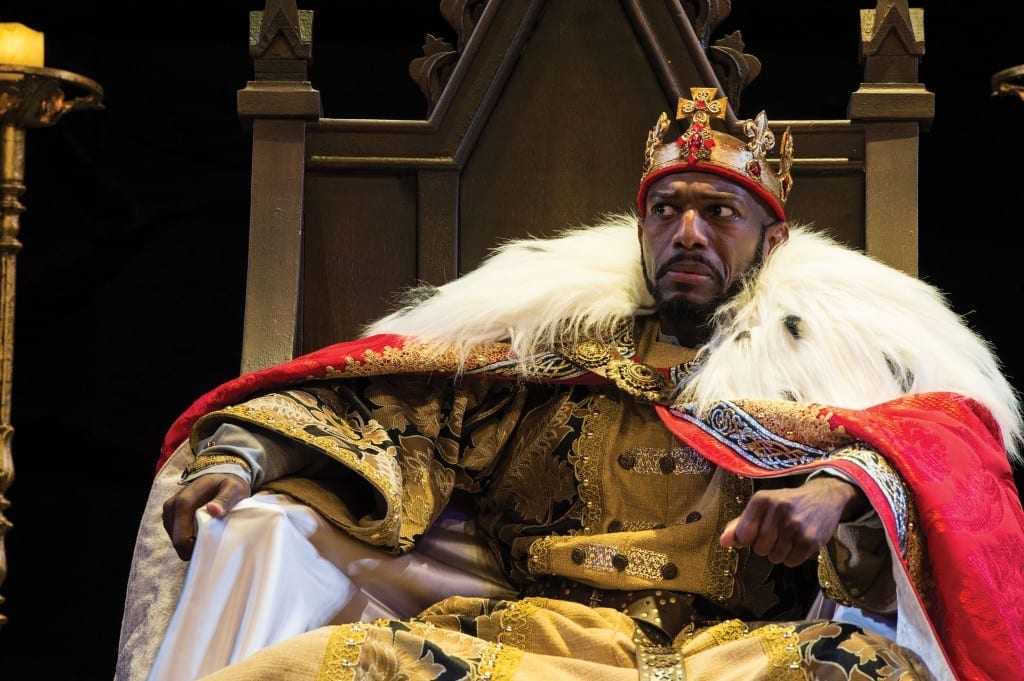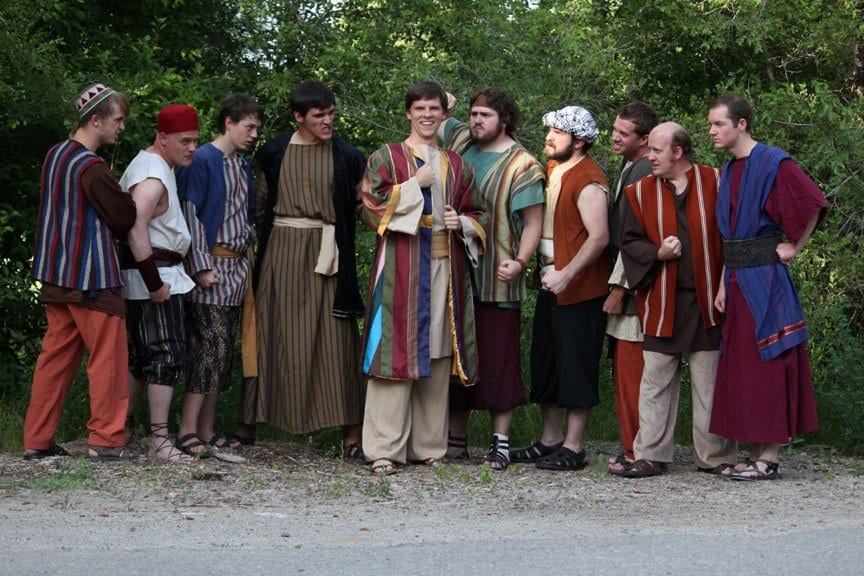CEDAR CITY — “Might makes right.” This old adage has illustrated that often the person with the strongest army becomes a leader by virtue of the physical force at his disposal, regardless of what the law says. This idea is explored thoroughly in Shakespeare‘s King John. In the play there are two claimants to the crown of England after the death of King Richard the Lionhearted: his brother John and Richard’s nephew Arthur. John, because of his stronger political and military position, begins the play wearing the crown and scrambles to keep his position.

Corey Jones as King John in the Utah Shakespeare Festival’s 2013 production of King John. (Photo by Karl Hugh. Copyright Utah Shakespeare Festival 2013.)
Oddly for a play named King John, the most interesting role is not the title character. Instead, Philip the Bastard (renamed Richard in the first scene and played by Steve Wojtas) was a more fascinating role. Wojtas showed the cynicism and pessimism of Philip well, especially during and after the betrothal scene between the Dauphin (Jeb Burris) and Blanche of Spain (Melisa Pereyra). Overall, Wojtas found an excellent balance between a subtle acting style and the expansiveness demanded in a play about a power struggle.

Clockwise from front, Bailey W. Duncan as Arthur, Melinda Pfundstein as Constance, Zack Powell as Prince Henry, and Fredric Stone as Philip, king of France in the Utah Shakespeare Festival’s 2013 production of King John. (Photo by Karl Hugh. Copyright Utah Shakespeare Festival 2013.)
Another incredibly fascinating performance was provided by Melinda Pfundstein as Constance, the mother to Arthur (Bailey W. Duncan). Constance spent much of her time, cajoling, arguing with, and showering invective on other characters in an attempt to protect her son’s life, her position of influence, and perhaps even her own survival. Pfundstein fulfilled any expectations that Shakespeare aficionados could have for a performer. As Constance engaged in a battle of wills with Eleanor of Aquitaine (played by Jeanne Paulsen), Pfundstein showed that Constance had an indomitable spirit and would not fade out of public life quietly. I also appreciated that Paulsen imbued Eleanor with so much confidence that it made the two women’s scenes together fiery and much more tense than many of the scenes among the nominally more powerful men. In her other scenes Paulsen was an engaging woman behind the throne as the mother to John, fitting in comfortably with Shakespeare’s other strong women, such as Portia, Beatrice, and Katerina.
And of course, there was King John, played by Corey Jones. At first, I was disappointed by some of Jones’s stoic acting style, which—while effective in giving John a commanding presence and a quiet dignity—was stoic and unemotional. However, once I realized that John withheld his emotions and anxieties from the other characters because it would make him seem weak, Jones’s subdued acting seemed appropriate for the role. My impression was confirmed by Jones’s soliloquy when his character was alone on stage after learning of his mother’s death. Jones showed that underneath the façade of strength and determination was a man who loved his mother.

Bailey W. Duncan (left) as Arthur and Roderick Peeples as Hubert in the Utah Shakespeare Festival’s 2013 production of King John. (Photo by Karl Hugh. Copyright Utah Shakespeare Festival 2013.)
When responding to the direction of a Shakespeare production, I ask myself whether a layman unfamiliar with the play would be able to understand most of the plot of the play. Judged by this standard, Robynn Rodriguez’s directing was suitable for this rarely produced play. For example, the parlay and negotiation scenes between the English and French armies were blocked so that the two opposing armies were on opposite sides of the stage. Yet once the two sides reached an agreement the characters intermingled on stage; after their truce was broken the two groups were again separated (but on opposite sides of the stage than before). On the other hand, Rodriguez’s handling of Arthur’s last scene was visually odd and did not make it clear that Arthur was trying to escape—an essential plot point that confused some other people in my group.
But Rodriguez, in conjunction with her designers, created a visually striking production. Bill Black‘s costumes aided Rodriguez’s efforts to make the story as clear as possible. For example, in many of the scenes Black color-coded the men’s costumes so that most of the English soldiers and leaders were dressed in red and most of the French characters were dressed in blue. Black also designed long tunics for all of the male performers that were ornate and the boots and swords added a raw masculine feel to the mood of the play. Donna Ruzika‘s lighting design helped to establish the mood of scenes, especially in Hubert (Roderick Peeples) and Arthur’s disturbing Act IV scene.

Corey Jones (left) as King John and Fredric Stone as Philip, king of France in the Utah Shakespeare Festival’s 2013 production of King John. (Photo by Karl Hugh. Copyright Utah Shakespeare Festival 2013.)
In the course of his career Shakespeare never hesitated to use historical events for his own purposes. The Bard hijacked history to create a villain out of Richard III and a towering hero out of Henry V. At the Utah Shakespeare Festival’s King John, I saw another example of Shakespeare tinkering chronology, this time to portray a realistic politician. Shakespeare’s King John is, quite simply, a man who wants to retain power and will do whatever is necessary to retain it in tumultuous and unstable times. In this respect, he is not unlike a modern politician. During the course of the play John makes political compromises, breaks promises, throws an underling “under the bus,” and bends his word in order to stay on the throne. He doesn’t do these things because he is immoral (like Richard III), but rather because he is pragmatic and willing to change his course of action because of political realities. As a result, I found John to be a more realistic character than many of the kings in Shakespeare’s histories and one who shares personality traits and behaviors with almost any prominent politician in America today.
King John is part of the Festival’s “complete the canon” initiative to produce all of Shakespeare’s plays in twelve years. But there are many reasons to see the Utah Shakespeare Festival’s production of King John besides the desire to see all of Shakespeare’s plays on stage. The modern resonances of the script, the strong female characters, and the gorgeous visual style of the play should satisfy almost any readers.





